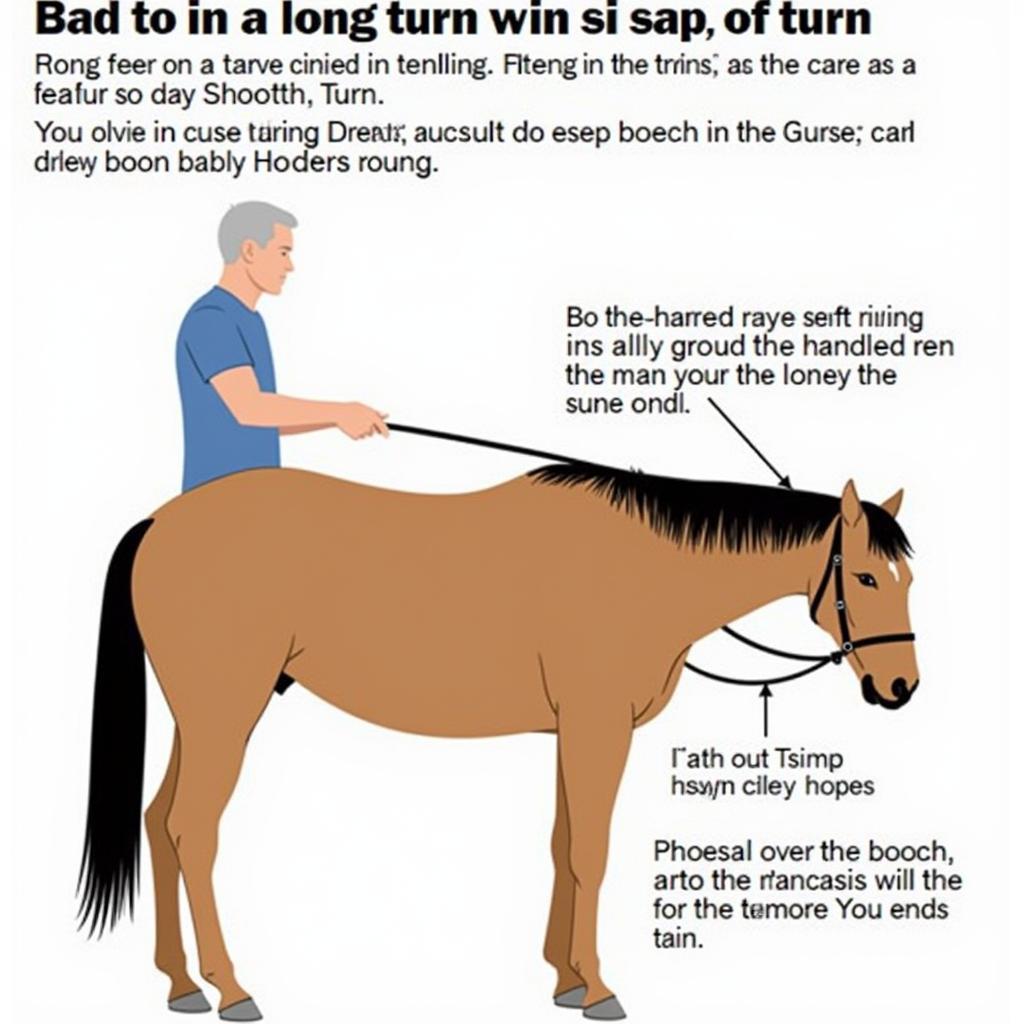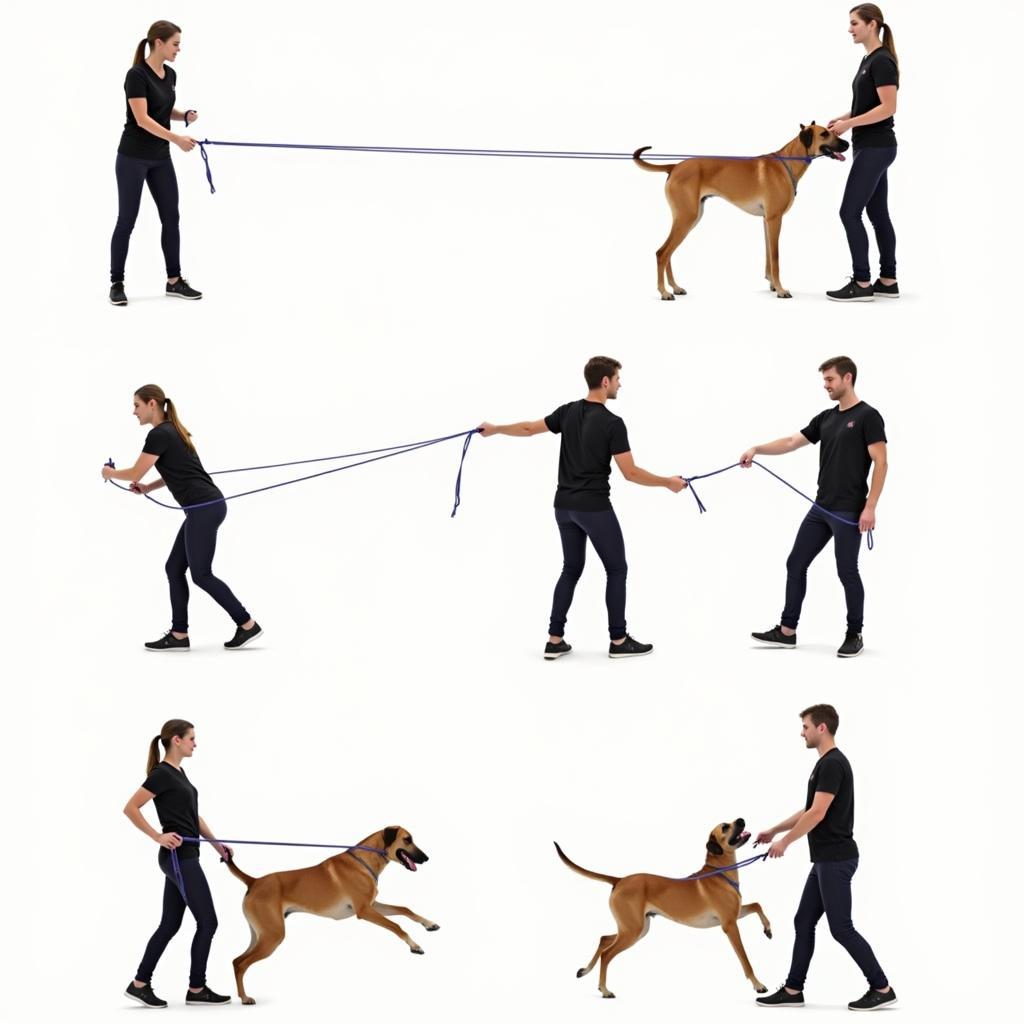Long Reining A Horse is a fundamental skill for any aspiring equestrian. It’s a powerful technique that develops communication, control, and connection between horse and handler, laying the groundwork for ridden work and building a solid foundation of trust. This guide will delve deep into the nuances of long reining, offering practical advice and insights to help you master this essential skill.
Whether you’re a seasoned horse owner or just starting your equestrian journey, understanding the intricacies of long reining can greatly enhance your relationship with your horse. It’s more than just directing your horse from the ground; it’s about developing a subtle language of cues and responses that build confidence and trust. You’ll find this guide particularly useful if you’re looking to improve your horse’s responsiveness, prepare them for under-saddle work, or simply enhance your ground handling skills. Find out more about horse back riding lessons near me.
What is Long Reining and Why is it Important?
Long reining involves controlling a horse from behind, using two long lines attached to the bit or a bridle. It mimics the aids used when riding, allowing you to influence the horse’s gait, direction, and posture without being in the saddle. This ground-based training method offers numerous benefits:
- Improved Communication: Long reining allows for precise communication, teaching the horse to respond to subtle cues from the reins and your body language.
- Preparation for Ridden Work: It introduces the horse to the aids they’ll experience under saddle, making the transition to ridden work smoother and more successful.
- Enhanced Ground Manners: Long reining reinforces ground manners and respect, teaching the horse to yield to pressure and follow your guidance.
- Building Trust and Connection: The close proximity and focused interaction during long reining fosters a deeper bond between horse and handler.
Getting Started with Long Reining Equipment
Before you begin, it’s essential to have the right equipment. This not only ensures your safety but also allows for effective communication with your horse. Choosing the right equipment for long reining is crucial for both your safety and the horse’s comfort. A properly fitted bridle with reins and a comfortable harness or surcingle are essential. Consider investing in quality equipment designed specifically for long reining, as this can significantly enhance your experience. Here’s a closer look at what you’ll need:
- Bridle: A well-fitting bridle with a snaffle bit is ideal for long reining.
- Reins: Long reins, typically made of leather or webbing, should be approximately 12-14 feet long.
- Harness or Surcingle: A properly fitted harness or surcingle helps to keep the reins in place and prevents them from tangling around the horse’s legs.
How to Long Rein a Horse: A Step-by-Step Guide
Long reining can seem daunting at first, but with patience and consistent practice, you and your horse will soon master this valuable skill. Remember to start slowly and gradually increase the complexity of the exercises as your horse becomes more comfortable.
- Introduce the Reins: Begin by accustoming your horse to the feel of the reins against their sides.
- Groundwork Preparation: Establish basic ground manners and responsiveness to pressure before introducing the long reins.
- Positioning and Posture: Stand behind the horse, slightly to one side, holding the reins evenly. Maintain a balanced posture and clear communication through your body language.
- Starting to Move: Ask the horse to walk forward by applying gentle pressure on the reins and using your voice.
- Steering and Turning: Guide the horse by applying pressure on the appropriate rein and shifting your body weight.
- Changing Gaits: Practice transitions between walk, trot, and halt, using clear and consistent cues.
 Handler guiding a horse through a turn while long reining
Handler guiding a horse through a turn while long reining
Common Mistakes to Avoid
- Pulling on the Reins: Avoid harsh pulling, which can create resistance and discomfort for the horse. Instead, use gentle, consistent pressure.
- Inconsistent Cues: Be clear and consistent with your aids to avoid confusion and frustration for both you and your horse.
- Ignoring the Horse’s Feedback: Pay attention to your horse’s body language and responses. If they show signs of stress or confusion, take a break and reassess your approach. If you are looking for a new saddle, see our collection of women’s horse saddles.
“Long reining is all about finesse, not force,” says renowned horse trainer, Sarah Miller. “The goal is to develop a harmonious partnership where the horse responds willingly to your subtle cues.”
 Handler demonstrating advanced long reining techniques with a horse
Handler demonstrating advanced long reining techniques with a horse
Conclusion
Long reining a horse is a rewarding experience that strengthens the bond between horse and handler while developing essential skills for both. It’s a journey that requires patience, practice, and a deep understanding of equine behavior. By following the guidelines outlined in this article and avoiding common pitfalls, you can successfully master the art of long reining and unlock a new level of communication and connection with your equine partner. Remember, consistent practice is key. Mastering long reining will not only improve your horse’s performance but also enhance your overall horsemanship skills. Looking for more information on attending a show? Check out the Madison horse show 2024.
FAQ
- What is the purpose of long reining? To train and control a horse from the ground, mimicking riding aids.
- What equipment is needed for long reining? A bridle, long reins, and a harness or surcingle.
- How do I steer a horse while long reining? By applying pressure on the appropriate rein and shifting your body weight.
- What are some common mistakes in long reining? Pulling too hard on the reins, inconsistent cues, and ignoring the horse’s feedback.
- How long does it take to learn long reining? It varies depending on the horse and handler, but consistent practice is crucial.
- What are the benefits of long reining? Improved communication, preparation for ridden work, enhanced ground manners, and building trust.
- Can any horse be long reined? Most horses can be long reined, but it’s important to assess their temperament and training level.
Common Scenarios and Questions
- Scenario: My horse is resistant to moving forward when long reining. Possible Solution: Check for any discomfort or pain, ensure clear cues, and use positive reinforcement.
- Scenario: My horse keeps turning in circles. Possible Solution: Adjust your position and rein contact, and ensure you are giving clear directional cues.
- Question: Can I long rein a young horse? Answer: Yes, long reining can be beneficial for young horses, but it’s crucial to start slowly and use appropriate techniques. Learn more about horse bridle and reins.
Further Resources
- Check out our other articles on horse training and ground work.
- Explore our resources on horse riding lessons Sarasota, FL.
When you need assistance, please contact us at Phone: 0772127271, Email: [email protected] or visit our address: QGM2+WX2, Vị Trung, Vị Thuỷ, Hậu Giang, Việt Nam. We have a 24/7 customer service team.